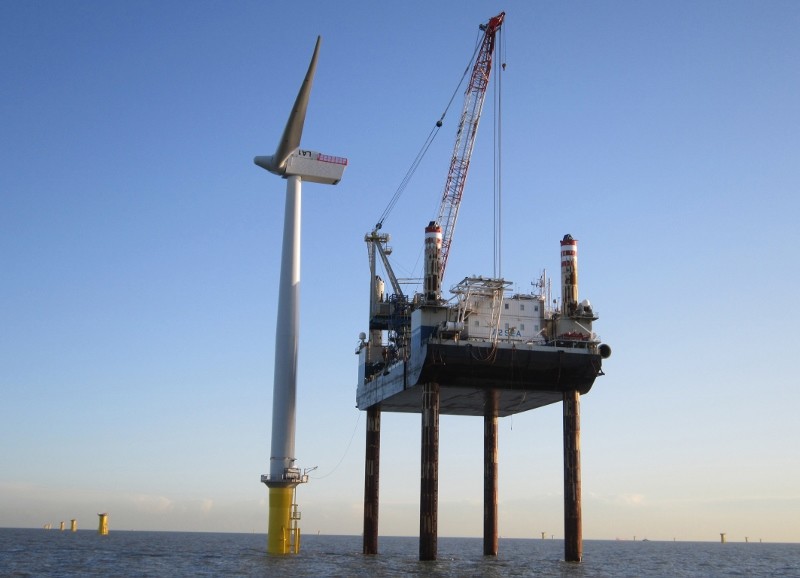Several paths are leading professionals to the nascent U.S. offshore wind industry, and no two paths are exactly alike. Many discover the sector through prior work in the maritime industry, but why they chose to join the fast-growing offshore wind sector often tends to be a personal choice.
For some people, such as Brigitte Hagen-Peter, a marine asset and operations manager based in Florida for Siemens Gamesa, the move into offshore wind was a natural progression. As a youth growing up in Florida, Hagen-Peter and her brothers would go boating anytime they could. She’d regularly drive the boat to the beach with her brothers so they could spend the day surfing. They’d travel the Intercoastal Waterway, past Port Everglades, and she would dream of her future.
“I’d look at all these massive ships from our little 17-foot Dusky and think, ‘How cool would it be to drive one of those,’” Hagen-Peter said.
Later, in following her passion for boating, she studied marine transportation and international maritime business at Massachusetts Maritime Academy. That led her to navigating tugboats at the Port of Miami, cruise ships around the Caribbean, and drillships in the Gulf of Mexico, then across the Atlantic into the Mediterranean and eventually around to the Indian Ocean. And that wandering, led her eventually into the new offshore wind sector.
But why is she optimistic about the offshore wind market, which is really just beginning in the U.S.? Mostly because real world facts support that enthusiasm. There is a lot of growth currently happening in this new sector.
“Siemens Gamesa’s bullish outlook on the U.S. offshore market is based on the commitments made by U.S. states and our federal government to support offshore wind-procuring commitments, improvements to increase efficiency and timing of the federal permitting processes, port and harbor improvements, and increased offshore wind lease activity along the East Coast, West Coast and the Gulf of Mexico,” Hagen-Peter said. “This is the exciting part, but it is really just the beginning. I’m very excited to be part of this industry that will build a better future.”
According to Environmental Entrepreneurs, a national nonpartisan group of business leaders who advocate for policies that are both good for the environment and the economy, many of the jobs that will be opening up in offshore wind will be a fit for professionals from a variety of backgrounds including ex-military members and even plumbers. The group expects offshore wind’s U.S. workforce to eventually number close to one million jobs.
Those jobs will cover many responsibilities, some of which seasoned mariners are no doubt familiar with — especially those mariners who have experience in offshore power generation. The jobs will cover a variety of areas, including work as site managers and supervisors, project engineers, quality control specialists, electrical technicians, oceanographers, geophysicists, technical trainers, and others.
Initially, the U.S. offshore wind industry will need many technicians and engineers. As the sector grows, though, many business and communications professionals will be needed, in order to help keep pace with that growth.
Those professionals who’ve already taken the leap into offshore wind are on the cutting edge.
Kyle Kingman, president of Offshore Power LLC, said his natural professional interests led him to offshore wind. It was an obvious choice. Being born, raised, and having settled in New Jersey, with a background in engineering geophysics and oceanography, he deliberately chose to work away from home among the world’s major offshore industry centers.
“My experience in subsea power transmission projects led to working largely in Europe since 2008 on many projects, including the world’s largest subsea power cable projects for the past decade,” Kingman said. “With the potential emergence of a viable U.S. offshore wind market and armed with the knowledge that energy generation is throttled by transmission, it made sense to bring that expertise home to the U.S. East Coast, which is now the next big frontier for offshore wind farms. New Jersey is central to East Coast offshore wind projects.”
Whether one is an engineer or technical type or not, the jobs expected to be created by the U.S. offshore wind industry will pay well, according to Environmental Entrepreneurs’ Clean Jobs, Better Jobs report on the growth of clean energy jobs. Workers in energy efficiency, grid modernization and storage, renewable energy, clean fuels, and clean vehicles earned a median hourly wage of $23.89 in 2019. That’s compared to the national average of $19.14 an hour.
“Jobs in many clean energy sectors are more likely to be unionized and come with health care and retirement benefits than the rest of the private sector, the analysis shows,” Environmental Entrepreneurs said.
For Stephanie McClellan, chief of strategy and policy for TotalEnergies SBE US, began working in offshore wind in 2009, when she began working as policy director for Delaware Gov. Jack Markell. She’s known for quite a while that this new industry could soon grow exponentially.
“Offshore wind is definitely on the cusp of a boom,” McClellan said. “For the past five years or so, states have been creating market opportunities for offshore wind, by committing their utilities to procuring energy from offshore wind farms—certain amounts, over a certain period of time. So, the market is certainly there for offshore wind.”
March 29 was a curtain raiser for companies anticipating the growth of this U.S. offshore wind industry. That was the day the Biden administration announced plans to build 30 gigawatts of offshore wind capacity by 2030.
Meeting that goal will require new manufacturing plants for offshore wind turbine components and new vessels to build and supply wind turbines
That means many jobs on the horizon, for those interested in joining this exciting new sector.
“The Biden administration's actions to date to lease additional ocean space in the New York Bight, as well as off the coast of California, demonstrates that they are not just playing ‘catch up,’ but are advancing new ambitions,” McClellan said.




